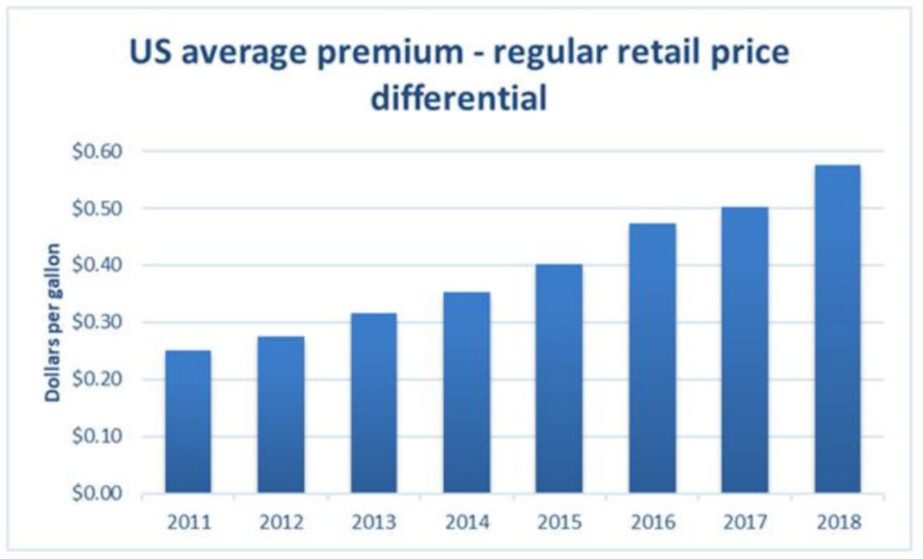Question 5: How will Tier 3 rules impact gasoline-producing units at your facility?
ABIGAIL SLATER (HollyFrontier)
The Tier 3 gasoline regulation partially took effect in 2017 and will be fully implemented in 2020. The Tier 3 gasoline regulation has impacted the refining industry in a myriad of ways as refiners reduce sulfur further. These impacts will be similar to most refineries, but will have varying severities based on refinery configuration, company compliance strategy, and market factors.
Most facilities reduce the overall gasoline pool sulfur by using Fluid Catalytic Cracking (FCC) Gasoline Hydrotreaters. The primary negative effect from increasing severity on FCC Gasoline Hydrotreaters is the reduction of FCC gasoline octane. It also impacts utility and unit cost of operations. The reduction of FCC gasoline octane impacts the octane balance on the refinery as a whole. This can be addressed in various ways. For example, increased Naphtha Reforming rate and severity, adjusting the sales of Premium Gasoline, adjusting the production and/or purchase of low octane gasoline blend stocks, or generating capital projects to increase the refinery octane balance are all ways to combat the reduction in FCC gasoline octane.
Another potential option to address the new sulfur constraint is to reduce the volume and/or concentration of high sulfur FCC gasoline. This can be done by adjusting FCC operation. Adjusting conversion (less FCC gasoline production), catalyst formulation, or fractionation (to lower gasoline distillation end point) can lower the FCC gasoline volume and/or sulfur concentration. By reducing the percentage of FCC gasoline in the overall pool, the overall sulfur is reduced. FCC catalyst vendors also have additives that can partition the sulfur from the gasoline to dry gas.
The strategies employed by each refinery will be different. There is not a “one size fits all” to solving the Tier 3 gasoline regulation. With that being said, the biggest issues to resolve will be to reduce sulfur while still maintaining the overall octane in the gasoline pool.
THOMAS PORRITT (Chevron U.S.A.) (2)
Managing feed sulfur for the FCC is a critical component of meeting Tier 3 specifications. FCC rates will depend on availability of internally produced and purchased low sulfur feed. Other higher-sulfur gasoline blend components will need outlets such as hydrotreating or mixing into export blends.
RICK DENNE (Norton Engineering Consultants, Inc.)
Many refiners are finding that with tier 3 the alkylate stream is now one of the larger contributors to the gasoline pool sulfur. For HF alkylation units, minimizing feed sulfur content has always been important for unit acid consumption. Now, the impact of feed sulfur to the alkylate product is of concern to the gasoline blender. Tight feed pre-treatment for sulfur is becoming more critical. For sulfuric acid alkylation units, an alumina bed treater either on the unit alkylate product stream or in place of the net effluent treatment section is an option to reduce product sulfur.
Refiners that have the FCC and Alkylation units on different turnaround schedules will find it very challenging to blending the butane/butylene stream if the sulfur treatment section is located within the battery limits of the Alkylation unit. Provisions must be made to keep the treatment section in service or find a means to store the higher sulfur butane/butylene stream during an Alkylation unit outage.
GEORGE HOEKSTRA (Hoekstra Trading LLC)
We have field test data from 12 commercial FCC gasoline desulfurizers that show higher octane loss than has been anticipated by the industry when making Tier 3 gasoline. The incremental octane loss when moving from Tier 2 to Tier 3 will likely be five times higher than was anticipated when the Tier 3 standard was enacted. None of the 12 commercial units in our field test data base indicates octane loss as low as that anticipated when the standard was enacted.
The octane will be lost when severity is increased in gasoline desulfurizers to lower the sulfur of FCC gasoline. In addition to octane loss, a lower product sulfur specification introduces new constraints on kinetic capacity, hydrogen availability, splitter effectiveness, feed flexibility, cycle life, synchronization of unit downtime, and processing of orphan streams requiring desulfurization. These constraints will surely come into play, especially in refineries that don’t have FCC pretreaters and those with gasoline desulfurizers not designed for Tier 3 service.
The biggest cost factor for Tier 3 is replacement of the octane lost in gasoline desulfurizers. This will be mostly done by increasing alkylate or higher-octane reformate in gasoline blends, which comes at a cost, and with capacity limits that depend on the refinery and feed. Some refineries are already paying $millions/month to replace lost octane with purchased alkylate.
When facing octane constraints, refiners can also reduce their production of premium gasoline and/or export non-compliant gasoline. But these remedies can really hurt profits because the retail value of octane in the US has tripled in recent years, making octane barrels an increasingly valuable commodity in the US market:

Most US refineries have never made Tier 3 gasoline in substantial volume. Now, with the issue urgent, many unknowns must be worked out in real time. The costs and benefits will be widely distributed across US refiners.
Our pilot plant and field test studies have led to development of new tools and methods to reduce octane loss in gasoline desulfurizers which can be implemented immediately with no capital investment. These optimization tools, and all the data on which they are based, are available to anyone at negligible cost through Hoekstra Trading.